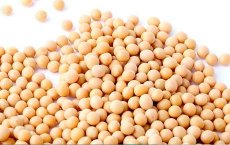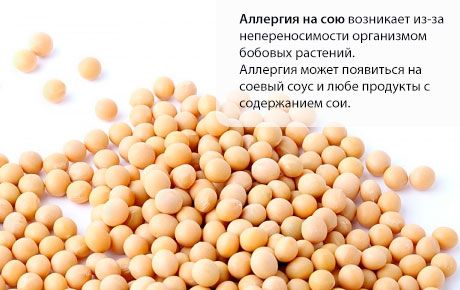Medical expert of the article
New publications
Soy allergy
Last reviewed: 05.07.2025

All iLive content is medically reviewed or fact checked to ensure as much factual accuracy as possible.
We have strict sourcing guidelines and only link to reputable media sites, academic research institutions and, whenever possible, medically peer reviewed studies. Note that the numbers in parentheses ([1], [2], etc.) are clickable links to these studies.
If you feel that any of our content is inaccurate, out-of-date, or otherwise questionable, please select it and press Ctrl + Enter.

Soy allergy is common and occurs in both adults and children. Let's look at the features of the appearance and course of an allergic reaction, as well as methods of treatment and prevention.
Soy allergy occurs due to the body's intolerance to legumes. Some people are allergic to certain types of legumes and do not know about it. Thus, an allergy can appear to soy sauce and any products containing soy. Babies are most susceptible to soy allergy. Allergy appears in babies at the age of three months and lasts until two to four years. In adults, soy allergy is less common, and if it does appear, it has clearly expressed symptoms.

Soy allergy is diagnosed very quickly. As a rule, a set of laboratory tests and symptoms (swelling, shortness of breath, runny nose, rash, etc.) are required for accurate diagnosis. The severity of symptoms depends on the individual characteristics of the body. Blood tests using ELISA technology are used for laboratory tests. This technology allows you to find out the level of antibody concentration in the serum and diagnose the body's sensitivity to certain allergens.
Causes of Soy Allergy
The main causes of soy allergy are related to individual intolerance of the body to legumes. Soy allergy is related to food allergies and occurs due to the effect of proteins on the immune system and the body. Thus, in some people, allergy symptoms appear sharply, while in others they are insignificant. Most often, soy allergy occurs in children and can provoke allergic reactions to other products.
To accurately determine the causes of soy allergy, you need to undergo diagnostics at an allergy center. The doctor will do skin tests with allergen extracts and take blood for analysis. After determining the cause of the allergy, treatment begins, which involves a complete rejection of soy products and legumes.
 [ 3 ]
[ 3 ]
Symptoms of Soy Allergy
Symptoms of soy allergy depend on the characteristics of the body. Thus, in some people the symptoms of allergy are pronounced, while in others they are insignificant. Let's look at the most common symptoms of soy allergy.
- Skin problems (rash, redness, swelling, eczema, hives, itching).
- Asthmatic attacks, shortness of breath, anaphylaxis, runny nose, conjunctivitis.
- Gastrointestinal diseases, nausea, diarrhea.
- Low blood pressure, weakness and fatigue.
These are the main symptoms of soy allergy, which occur in both adults and children. But very often, in the absence of proper diagnosis, the symptoms of soy allergy are confused with other allergic reactions and diseases and the wrong treatment is prescribed, which only worsens the condition of the body.
Soy allergy in children
Soy allergy in children occurs in every third baby. As a rule, the allergic reaction appears at the age of three months and can last up to three or four years. The allergy occurs due to baby food, which contains nutritious soy protein, which provokes adverse reactions in the body.
Symptoms of soy allergy in children include skin dermatitis, urticaria, and itching. Often, a child develops a runny nose, rhinitis, shortness of breath, and asthma attacks. Soy allergy in children provokes gastrointestinal problems (colitis, diarrhea, flatulence, nausea). In very severe cases, the allergy causes anaphylactic shock, swelling, and low blood pressure.
 [ 4 ]
[ 4 ]
Diagnosis of soy allergy
Diagnosis of soy allergy is the first step towards treatment and recovery. Diagnosis is carried out in an allergy center by an allergist or immunologist. The patient undergoes tests for food intolerance and skin tests with allergen extracts. Symptoms of soy allergy are also of great importance during diagnosis. In addition, blood is taken from the patient for analysis and a skin scraping is taken.
Diagnosis of soy allergy should be carried out immediately after the first symptoms appear. As this allows for the correct and effective treatment to be prescribed, which will relieve symptoms and cure soy allergy.
 [ 5 ]
[ 5 ]
Treatment for soy allergy
Treatment of soy allergy is prescribed after a complete diagnosis of the disease. Treatment begins with a complete refusal of products that contain soy and legumes. This helps protect the body from allergens. It would not be superfluous to follow a special diet that is aimed at restoring the immune system. If the symptoms are quite severe, the patient is prescribed medication. Patients are prescribed antihistamines and blockers.
Treatment of soy allergy also depends on the patient's age. If the allergy is diagnosed in children, then the treatment involves refusing to eat soy products and taking vitamins to restore the immune system. Please note that children who have had soy allergy in childhood are immune to the disease in adulthood.
Preventing Soy Allergy
Prevention of soy allergy begins with a complete rejection of soy and products that contain it. It is necessary to refuse soy milk, baby food that contains soy, tofu, soy sauce, some types of cereals, soy curd, bean sprouts, baked goods made from soy flour, meat products (sausages, hot dogs, pates) and a number of other products. It is difficult to avoid eating soy and products containing it, so it is very important to read the packaging and monitor the state of the body when eating legumes.
Soy allergy is a common food allergy that no one is immune from. The only way to protect yourself from painful symptoms is to eliminate soy and soy-containing products from your diet.

